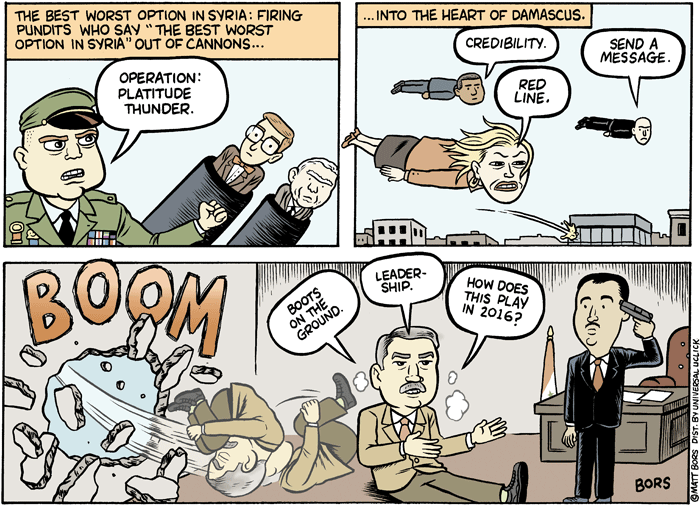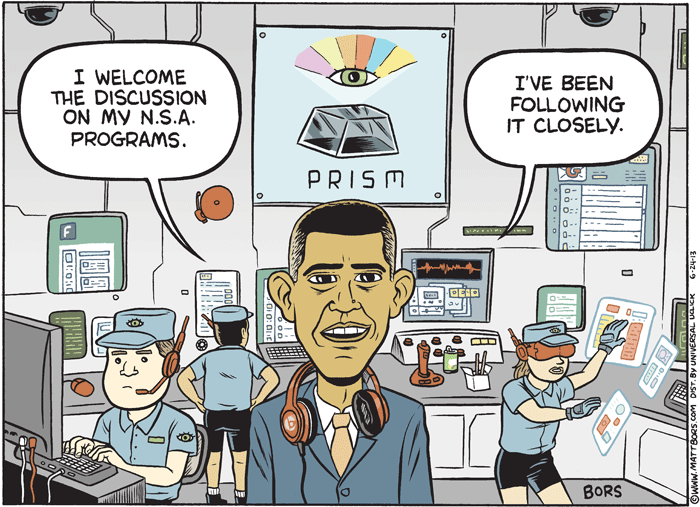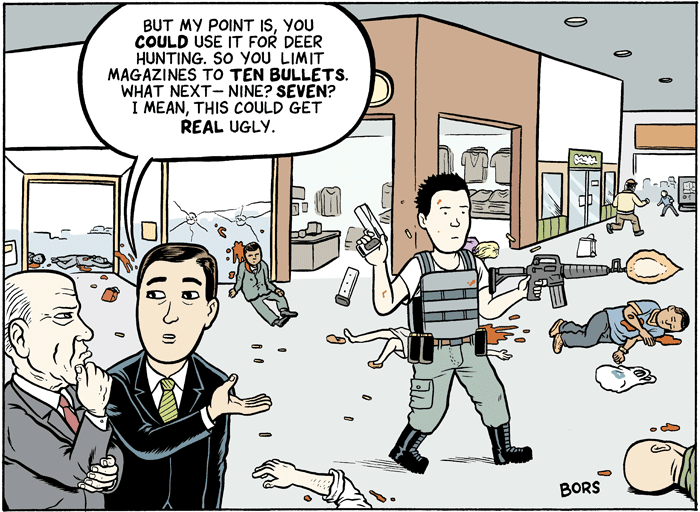
Northern Syria, home to murder, kidnapping and sniper fire, is a pretty strange place to stage a cartoon. Yet that’s the setting that military correspondent David Axe and cartoonist Matt Bors have chosen for their next collaboration, a work about drone warfare. Their column, to be published Wednesday on the website Medium, will attempt to show “firsthand what it’s like living under the constant threat of regime air attack,” Axe said recently.
This isn’t the first time that the pair has chosen war as the setting for their work. They published the graphic novel War Is Boring in 2010 about Afghanistan, where the two traveled separately in 2009 and 2010.

Through these projects Bors, 30, is upending the musty and tired tradition of political cartooning, reclaiming an old-fashioned form for modern readers. Editorial cartooning, he said in a recent interview, has become stuffy and elitist. His gutsy approach has earned him establishment credibility, landing Bors a spot as one of the two finalists for the Pulitzer Prize in Editorial Cartooning in 2012.
Bors’ style is a break from a long tradition, stretching back to the 19th century illustrator Thomas Nast, best known for his cartoons about the corrupt New York City political organization, Tammany Hall, and for making ideas like the Democratic donkey and Uncle Sam household metaphors. Since then, the images and ideas of editorial cartoons have undergone few and infrequent changes, and the cartoons themselves are often drawn with muted colors, grey scale, and written with a removed, deadpan humor found often in the work of contemporary cartoonists Mike Luckovich and Nick Anderson.
Bors is different. He examines the world of politics with a glancing irony — earnest and snarky — both made for and shaped by a generation that gets most of its news from The Daily Show. Bors has departed from the traditional single-frame format of his medium and has started working on lengthy pieces. He’s leading a group of cartoonists who are expanding what we can expect from political cartoons.

“I’m a lot more interested in breaking out from this little rectangle,” Bors said in a recent interview. His style demonstrates this well: Bors uses rich colors and strays from the standard white background that has become so ubiquitous in his craft. He sticks to a quirky illustrated style that relies heavily on the depiction of eyes and larger-than-life heads for his subjects — a style more closely related to comic books or made-for-adult cartoon television shows than newsprint. Bors’ cartoons, in short, work well on a computer screen.
The Ohio native is at the forefront of a movement known as comics journalism. At its best, the work resembles a magazine profile more than traditional editorial commentary. Bors’ cartoons are part reportage and part travel-log, delivering recorded conversations and details from his travels. Others like Ted Rall and Tom Tomorrow pioneered the approach, but the method has become Bors’ signature style.
In September, Bors published a long-form cartoon on unpaid internships at Medium. Alongside several cartoon panels and infographics, Bors created a statistical analysis of internships, calculating how much money interns nationwide are being cheated out of in a single summer. The piece was viewed by more than a quarter of million people within the first week of publication, making it one of Medium’s most popular posts so far.
Earlier this summer, Bors produced a cartoon op-ed for CNN called “Can we stop worrying about millennials yet?” It looked at the recent obsession with that generation’s supposed failures, digging into employment rates and the cost of education. His piece was an attempt to parry the increasingly popular notion that recent college graduates are any lazier or more entitled other recent generations.
When done well, comics journalism can blur a distinction between drawing and journalism. And if reported journalism seems out of place in a comic, it is because of a staid tradition that cartoonists like Bors and Rall have been trying to circumnavigate and subvert. Bors has been editing a series called The Nib, which publishes work by both established and up-and-coming cartoonists. This work reflects the sort of change in direction Bors believes comics journalism can take — changes he set a pace for while working with Axe and while in Afghanistan.
Their work gets its power by combining accessibility with the reporting and research. To take it one step further and display, as Bors did with his Millennials and Internships columns, a grim sense of humor allows him to get his message across more effectively: “I think there’s something to using humor to get across political points about things that are in reality terribly depressing,” Bors said.

One of Bors’ next projects will cover the protest of Jacqueline Smith, the last resident of Memphis’ Lorraine Motel, where Martin Luther King Jr. was shot and from where Smith was evicted to make way for the National Civil Rights Museum on the site.
“I always had an interest in nonfiction writing and politics,” he said, “to me it seems like a natural transition.”
Bors indicates a direction comics journalism may be taking in the near future by becoming a tool of reporting for battlefield journalists and editorial writers alike.
“I draw cartoons that are words and pictures,” Bors said, “it’s one of the most accessible, populist art forms because of that — it’s meant to be understood.”
Axe has shown a particular enthusiasm for Bors’ art. The two have collaborated many times since 2007, when they met at a comics convention in Washington, D.C. In October, the pair completed perhaps their most permanent collaboration. In honor of their current project, Axe had Bors ink a tattoo of a drone on his arm.

